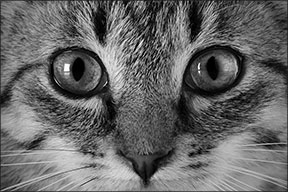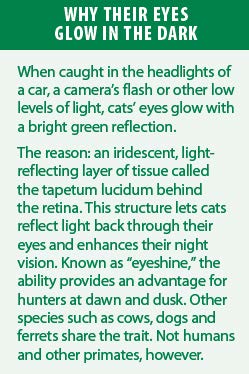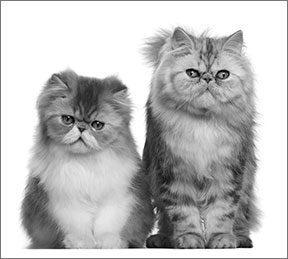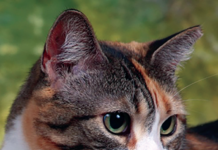If you suspect your cat sees the world differently, you may be right. The complex anatomy of a cat’s eye results in less focused vision than ours, and he likely sees only a limited range of colors. On the other hand, these historically nocturnal predators boast superior night vision and skill in detecting motion, making their vision all the better for hunting.

288
Cats have “low-resolution” vision when compared to people because they have a proportionately lower number of what are called cone cells in their retinas — the light-sensitive layer at the back of the eye. The cone cells help make images sharp.
“The tradeoff is that cats generally have better night vision than people do because their cone cells and their counterparts the rod cells are distributed differently than in humans,” says ophthalmologist Seth Eaton, VMD, DACVO, Cornell University Veterinary Specialists in Stamford, Conn. “We believe it may represent an evolutionary advantage to cats, a nocturnal prey-seeking species, affording them better night vision.”
Of course, cats can’t read eye charts, so it’s difficult to know exactly how well they see in normal light conditions, but estimates of visual acuity range from 20/50 to 20/200. That means that what a person can see in detail at 50 feet or even up to 200 feet, cats can see well only at 20 feet. “I always tell owners that it doesn’t mean that you should be worried that their pets aren’t seeing well and they need glasses,” Dr. Eaton says. “Their visual acuity is dependent on a lot of different factors.”

The general blueprint for the anatomy of the eye is much the same for cats and people, he says. All mammals have a cornea — a clear window in the front of the eye — as well as a lens that sits roughly at the middle of the eye and provides focus. The most important structure we all have for vision is at the back of the eye — the retina, a membrane made of hundreds of thousands of tiny cells that are responsible for generating the images we see.
Dr. Eaton fields many queries from pet owners puzzled about feline vision. He takes some of the mystery out of the topic here.
Can Cats See Colors? While humans normally see a wide range of colors, cats and dogs appear to see a more limited spectrum. Dogs, for example, are thought to be akin to people with typical color-blindness, Dr. Eaton says, and they likely have trouble differentiating red and green. That’s because of the difference in the retina, specifically in the pigments within the retinal cells. Dogs have only two types of pigments in their retinal cells. Humans with normal color-seeing ability have three different types. Cats are a little controversial; most sources believe cats, like dogs, have two pigments, Dr. Eaton says, but a study contends that cats may have three. So feline color vision is at least similar to dogs and cats might even enjoy a slightly broader spectrum.

288
Are Cats Prone to Nearsightedness? Yes, some cats may see better up close. A study of 98 healthy normal domestic cats published recently in the American Journal of Veterinary Research found that domestic shorthair cats were significantly likelier to be nearsighted than longhair or medium-hair cats. “In almost all cases, we would never know it,” says Dr. Eaton. “They compensate very well.”
My Cat Has Gone Blind — What Now? In reality, cats adapt to vision loss, even when it’s sudden. Owners’ efforts can help the transition, such as by talking to your cat before touching him or entering a room, and by not moving furniture, the ASPCA advises. “Dogs and cats are incredibly adaptable and can have a great quality of life with their vision impairment, regardless of the underlying cause,” Dr. Eaton says.
Surprisingly, blindness is reversible in some cases. A number of factors can lead to blindness in cats, including eye inflammation, glaucoma, cataracts, trauma, inherited disease and a reaction to certain drugs. Cataract surgery can restore what might have been minor or total loss of vision. The surgery is similar to human cataract surgery, and best results occur when removed early.
“What I think is important for owners to know,” Dr. Eaton says, “is before assuming that it’s an unfixable problem, as many owners might understandably do, they probably should consult with their veterinarian or a veterinary ophthalmologist because in some cases, those problems can be identified and fixed.” (To find an ophthalmologist near you, ask your pet’s veterinarian or visit the American College of Veterinary Ophthalmologists website: www.acvo.org.)
The Best Advice for Healthy Vision. “Some conditions like cataracts occur mainly at the microscopic level,” Dr. Eaton says, “so it’s important to have your veterinarian check your cat’s eyes for subtle changes during annual exams or when you suspect a problem.” ❖



